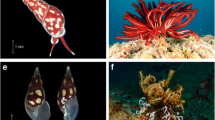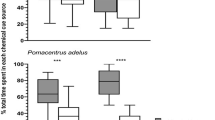Abstract
Laboratory experiments conducted during 1987 on Appledore Island, Maine, USA, tested whether feeding preference or the absence of an attractant was the cause for the occurrence of beds of Codium fragile ssp. tomentosoides (herein referred to as “Codium fragile”) within rocky barrens grazed clear of kelp by the sea urchin Strongylocentrotus droebachiensis. Consumption of C. fragile in single-diet experiments (1 seaweed/sea urchin) was highly variable and was not significantly different from that for several other seaweeds (Agarum cribrosum, Ascophyllum nodosum, Chondrus crispus, and Laminana saccharina) important in the field diet of the green sea urchin. In multiple-diet experiments (5 seaweeds/sea urchin) significantly less Codium fragile was eaten than Chondrus crispus, but significantly more Codium fragile was eaten than A. cribrosum. Chemosensory experiments suggest that C. fragile does not attract the sea urchin. Sea urchins are unable to detect C. fragile but will eat it when they come in contact with it.
Similar content being viewed by others
Literature cited
Breen, P. A., Mann, K. H. (1976). Destructive grazing of kelp by sea urchins in Eastern Canada. J. Fish. Bd Can. 33: 1278–1283
Brownlee, K. A. (1967). Statistical theory and methodology in science and engineering. 2nd ed. John Wiley & Sons, Inc., New York
Carlton, J. T., Scanlon, J. A. (1985). Progression and dispersal of an introduced alga: Codium fragile spp. tomentosoides (Chlorophyta) on the Atlantic coast of North America. Botanica mar. 28: 155–156
Castilla, J. C., Crisp, D. J. (1970). Responses of Asterias rubens to olfactory stimuli. J. mar. biol. Ass. U.K. 50: 829–847
Fralick, R. A., Mathieson, A. C. (1973). Ecological studies of Codium fragile in New England, USA. Mar. Biol. 19: 127–132
Fuji, A. (1967). Ecological studies on the growth and food consumption of Japanese common littoral sea urchin Strongylocentrotus intermedius. Mem. Fac. Fish. Hokkaido Univ. 15: 82–160
Hay, M. E., Lee, Jr., R. R., Guieb, R. A., Bennett, M. M. (1986). Food preference and chemotaxis in the sea urchin Arbacia punctulata (Lamarck) Philippi. J. exp. mar. Biol. Ecol. 96: 147–153
Himmelman, J. H., Nédélec, H. (1990). Urchin foraging and algal survival strategies in intensely grazed communities on Eastern Canada. Can. J. Fish. aquat. Sciences 47: 1011–1026
Keppel, K. (1982). Design and analysis. A researcher's handbook. 669 pp. Prentice Hall, Englewood Cliffs, New Jersey
Klinger, T. S. (1982). Feeding rates of Lytechinus variegatus Lamarck (Echinodermata: Echinoidea) on differing physiognomies of an artificial food of uniform composition. In: Lawrence, J. M. (ed.) International echinoderm conference. A. A. Balkema, Rotterdam, p. 29–32
Larson, B. R., Vadas, R. L., Keser, M. (1980). Feeding and nutritional ecology of the sea urchin Strongylocentrotus droebachiensis in Maine, USA. Mar. Biol. 59: 49–62
Peterson, C. H., Renaud, P. E. (1989). Analysis of feeding preference experiments. Oecologia 80: 82–86
Prince, J. S. (1988). Sexual reproduction in Codium fragile spp. tomentosoides (Chlorophyceae) from the northeast coast of North America. J. Phycol. 24: 112–114
Schiel, D. R. (1982). Selective feeding by the echinoid, Evechinus chloroticus and the removal of plants from subtidal algal stands in northern New Zealand. Oecologia 54: 378–388
Steinberg, P. D. (1985). Feeding preference of Tegula funebralis and chemical defenses of marine brown algae. Ecol. Monogr. 55: 333–349
Steinberg, P. D. (1988). Effects of quantitative and qualitative variation in phenolic compounds on feeding in three species of marine invertebrate herbivores. J. exp. mar. Biol. Ecol. 120: 221–237
Sze, P. (1986). A biology of the algae. Wm. C. Brown Publishers, Dubuque, Iowa
Vadas, R. L. (1977). Preferential feeding: an optimization strategy in sea urchins. Ecol. Monogr. 47: 337–371
Wassman, E. R., Ramus, J. (1973). Primary-production measurements for the green seaweed Codium fragile in Long Island Sound. Mar. Biol. 21: 289–297
Author information
Authors and Affiliations
Additional information
Communicated by J. M. Lawrence, Tampa
Rights and permissions
About this article
Cite this article
Prince, J.S., LeBlanc, W.G. Comparative feeding preference of Strongylocentrotus droebachiensis (Echinoidea) for the invasive seaweed Codium fragile ssp. tomentosoides (Chlorophyceae) and four other seaweeds. Marine Biology 113, 159–163 (1992). https://doi.org/10.1007/BF00367649
Accepted:
Issue Date:
DOI: https://doi.org/10.1007/BF00367649




